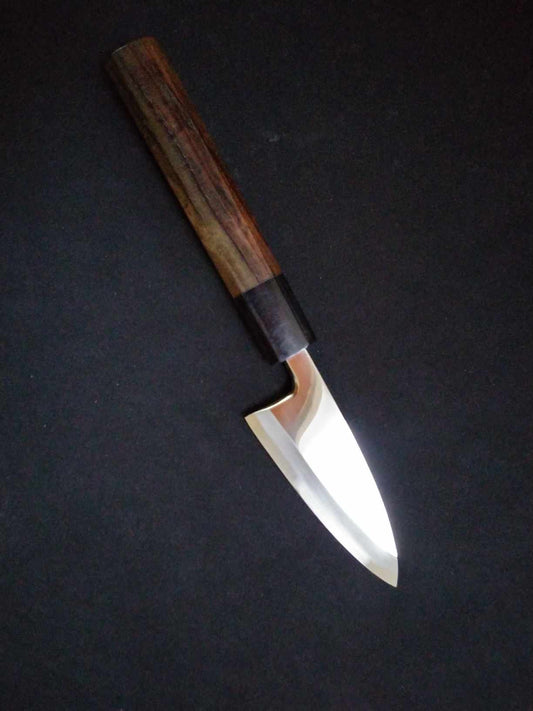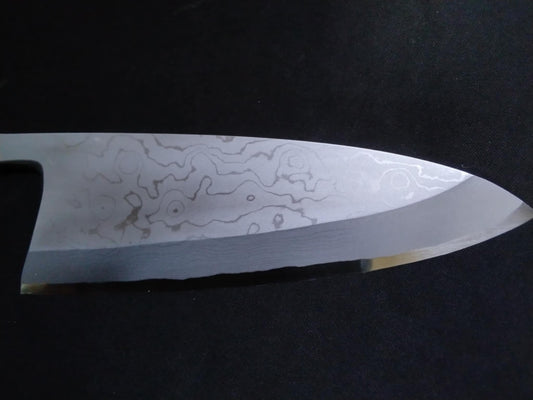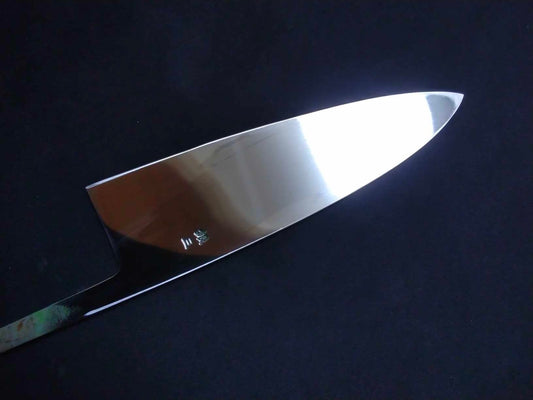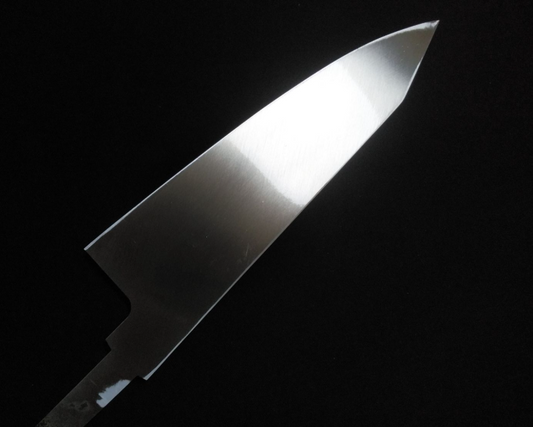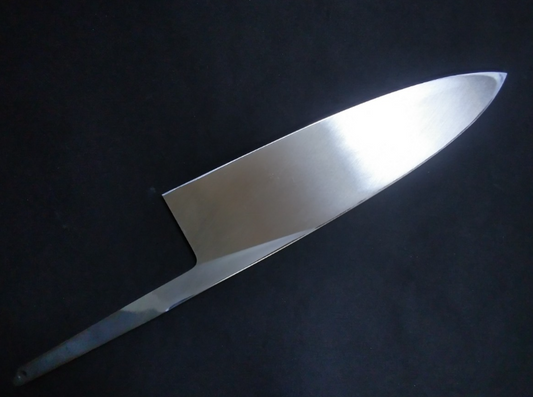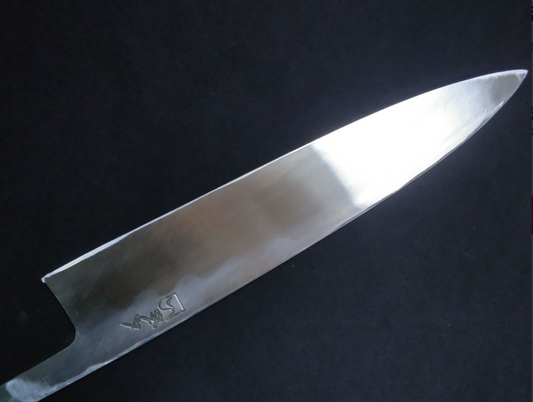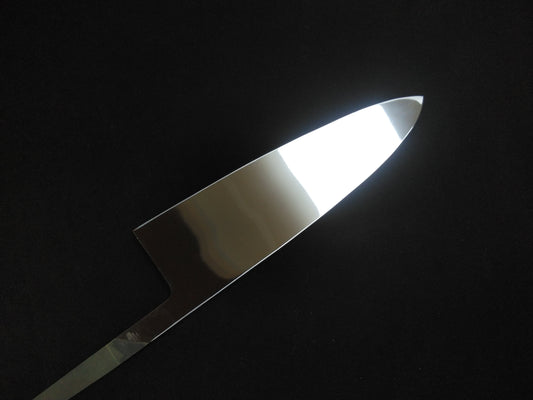
Deba: The Japanese Knife Born to Break Through Bone.
-
The Deba is Japan’s powerhouse knife for filleting fish.
Thick, heavy, and precise — a blade born from tradition, trusted by chefs. -
Deba Japanese Knife Collection
-
White Steel #2 KoDeba(Small Deba) 90mm-Mirror Polished(one side)
Regular price $220.00 CADRegular priceUnit price / per$0.00 CADSale price $220.00 CAD -
Blue Steel #2 Deba 170mm- Kido Finishing
Regular price $320.00 CADRegular priceUnit price / per$0.00 CADSale price $320.00 CADSold out -
White Steel #2 Damascus Deba 150mm-Mirror Polished Blur Finish
Regular price $346.00 CADRegular priceUnit price / per$0.00 CADSale price $346.00 CADSold out -
Ginsan Deba 180mm -Mirror Polished(both sides)
Regular price $403.00 CADRegular priceUnit price / per$0.00 CADSale price $403.00 CADSold out -
Ginsan Deba 210mm -Mirror Polished(one side)
Regular price $430.00 CADRegular priceUnit price / per$0.00 CADSale price $430.00 CADSold out -
White Steel #2 Damascus Deba 210mm-Mirror Polished Blur Finish
Regular price $450.00 CADRegular priceUnit price / per$0.00 CADSale price $450.00 CAD -
Blue Steel #2 Deba 240mm- Mirror Polished(one side)
Regular price $500.00 CADRegular priceUnit price / per$0.00 CADSale price $500.00 CAD -
Super Steel (Honyaki) Deba 210mm-Mirror Polished(both sides)
Regular price $774.00 CADRegular priceUnit price / per$0.00 CADSale price $774.00 CAD
KIREAJI's Three Promises to You
-

1. Exceptional Japanese Knives
Our knives, crafted by Sakai City's master artisans, combine traditional techniques with carefully selected materials, delivering unrivaled sharpness and durability.
-

2. For a Lifetime of Use
At KIREAJI, we see knives as lifelong companions. Each knife comes with a free saya, and we offer Honbazuke hand-sharpening by Shiroyama Knife Workshop in Sakai City.
-

3. Supporting the Joy of Continued Use
KIREAJI knives are made to grow with you. That’s why we provide trusted after-sales care (fee-based) .
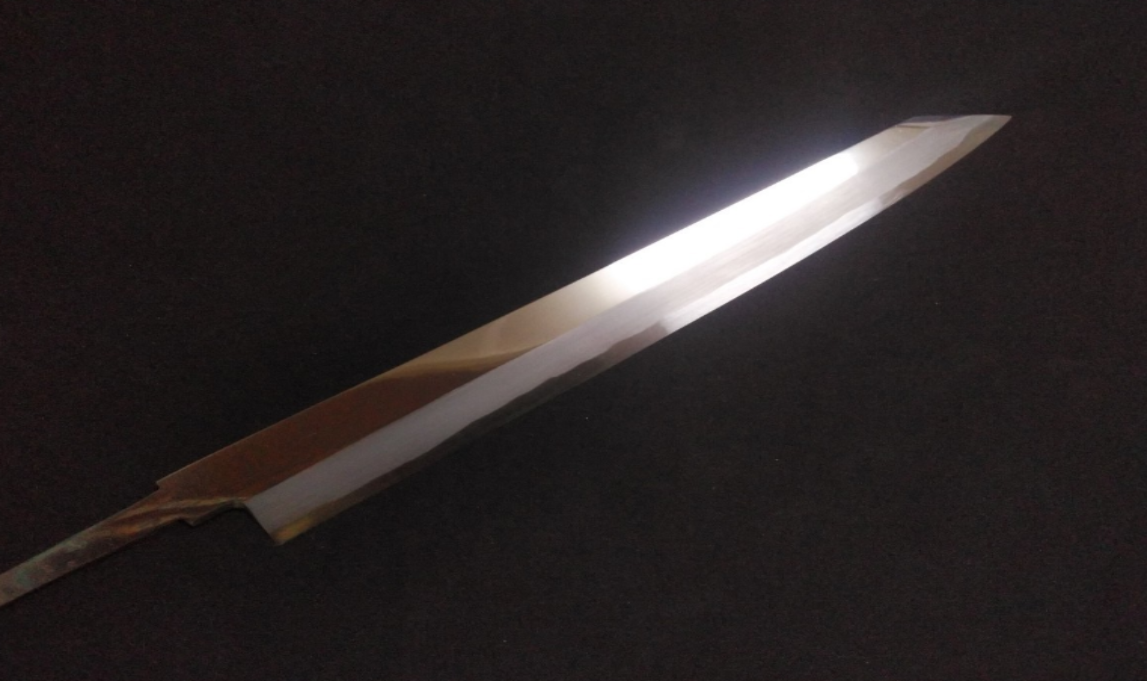
Why Many Product Photos Show Only the Blade
At KIREAJI, every knife is Made to Order.
That means your knife is completed — handle attached and final adjustments made — only after you place your order, by skilled artisans in Sakai, Japan.

Global Delivery from Sakai
Across the world, discerning customers seekgenuine Japanese knives crafted in Sakai.
At KIREAJI, we work alongside the master artisans of Sakai to fulfill that desire — shipping authentic Japanese knives straight from Sakai to kitchens around the globe.
Deba
-
Discovering the Deba — Understanding the Weight
When you first hold a Deba, one thing stands out immediately: its weight.
With a thick, wide blade and a solid, hefty feel, it may seem more like a small hatchet than a kitchen knife—especially if you're used to Western chef’s knives.But don’t be mistaken—this is not simply a heavy knife.
The Deba is a tool refined through centuries of Japanese culinary tradition, created for one purpose: to face the fish with respect, precision, and resolve.To hold a Deba is to engage in a kind of ritual. It’s not just cutting fish—it’s about entering a quiet battle where technique and respect are everything.
-

What Is a Deba?
The Deba is a traditional Japanese single-bevel knife designed specifically for preparing fish.
Its most distinctive features are its thick spine, broad blade, and single-edged design. These elements work together to let the knife cut cleanly through bones without cracking them, while also gliding smoothly along the fish’s skeleton to preserve delicate flesh.
Blade lengths usually range from 15cm to 21cm (6 to 8 inches).
Smaller Deba are used for river fish like ayu or small seabream, while larger versions are ideal for big fish like tuna or yellowtail.
In Japanese cooking, choosing the right size of Deba based on the fish is second nature. -
It’s Not Just “Cutting”—It’s Guiding the Blade
Unlike Western knives that are double-edged, the Deba is sharpened on only one side.
This single-bevel design allows the blade to "hug" the bones of the fish, making precise, fluid cuts with minimal resistance.When filleting a fish, the Deba’s edge feels like it speaks to the bone, telling you where to move.
As one instructor at my sushi school in Tokyo once said,
“Listen to the fish. The Deba will answer.”
At the time, it sounded poetic, maybe even a little silly. But years later, I understand exactly what he meant. -

Let the Knife Do the Work
One of the Deba’s signature traits is its weight.
But this isn’t a flaw—it’s a feature.Rather than forcing your way through a fish, you let the Deba’s own weight and gravity do the work.
When dropping the blade to remove a fish head, for example, it’s not about strength—it’s about angle, timing, and technique.Push too hard, and you’ll crack bones or chip the blade.
Use it right, and the Deba moves with quiet precision.This is the essence of Japanese knife philosophy:
The craftsman and the tool work together. -
Facing the Fish — Why the Deba Matters
The Deba is used at the very beginning of the cooking process—before heat, seasoning, or plating.
It’s at this stage that a dish’s entire character can be defined.
A clean fillet preserves texture. A poorly cut one bleeds flavor, ruins the structure, and wastes what could have been a perfect meal.In Western cuisine, heat often transforms the ingredient.
But in Japanese cuisine, the goal is to preserve the ingredient’s natural beauty and flavor. That’s why the knife is, in a sense, our “fire.”So the Deba is not just a knife—it’s a philosophy held in steel. It reflects how we approach food, respect life, and craft flavor from the very first cut.
-
In Conclusion: The Deba Is More Than a Tool
The Deba is not just a “fish knife.”
It is a manifestation of Japanese culinary philosophy, forged through centuries of discipline and aesthetic refinement.To hold one is to ask yourself:
“How do I choose to face the ingredients before me?”And in your answer, you will find yourself—not just a cook, but a craftsman.
Tracing the Roots of the Deba — A Tool Forged in Tradition and a Hint of Humor
-
When you first pick up a Deba, you're likely to notice its solid weight and thick blade. This isn’t just a heavy-duty kitchen tool—it’s a product of centuries of Japanese culinary wisdom, built for precision, durability, and versatility in fish preparation.
-

-
Born in Sakai — Japan’s Legendary Blade-Making City
The Deba originated during the Edo period in Sakai, a coastal city in Osaka known for its long-standing tradition of blade craftsmanship. Once famous for making samurai swords, Sakai later became Japan’s capital for kitchen knife production.
As fish became a dietary cornerstone in Japan, cooks needed a blade that could cut through heads and bones but also slice delicately through tender flesh. Thus, the Deba was born—a thick, single-beveled knife designed to do it all. Its design has changed little over the centuries, because frankly, it didn’t need to.
To this day, Deba are hand-forged by skilled artisans using traditional methods. The fact that its shape and structure have endured is a testament to just how perfectly it was conceived.
-

-
The Name “Deba” — Serious Tool, Playful Origin?
Now, here's where things get interesting—and a bit amusing.
While "Deba" may sound like a technical term, one folk etymology suggests a more playful origin.According to a popular theory, the first craftsman to create this blade had a rather noticeable overbite, known in Japanese slang as "deppa" (出っ歯). In Japanese, “de” (出) means “to stick out,” and “ha” (歯) means “tooth.” So, someone with buck teeth might be jokingly called "deppa." Over time, the blade he created came to be known as the "Deba" — a kind of pun that blends physical humor with legacy.
Is it historically accurate? Probably not.
Is it still retold with a smile by chefs and knife enthusiasts? Absolutely.This story highlights something special about Japanese craftsmanship: while the work is precise, disciplined, and steeped in tradition, there’s often a touch of human warmth and humor in how tools—and the people behind them—are remembered.
-
More Than Just a Blade
The Deba is a tool of purpose and elegance, but it’s also a window into the culture, values, and wit of the people who created and used it. So the next time you reach for a Deba, remember—you’re not just holding a knife. You’re holding a slice of culinary history, complete with craftsmanship, tradition, and a little inside joke that’s been passed down for generations.
Why Are Deba Knives Thick?
-
The Ultimate Knife Design for Reliability and Versatility
Deba knives are engineered as the ultimate multi-functional kitchen tool—designed to handle every task, especially fish filleting, with a single knife. Their design goes beyond mere aesthetics; it embodies a blend of tradition, experience, and modern precision that ensures both functionality and durability in the demanding culinary world.
-

1. The Secret of Thickness: Preventing Energy Loss
When chopping a fish’s head, you need to deliver a powerful, decisive cut along the joints. A thin blade can flex under such force, causing energy to dissipate instead of translating into a clean cut. Deba knives feature a thicker blade that concentrates your force at the point of impact, ensuring steady, reliable cutting power. This design guarantees that even under heavy stress, the knife efficiently slices through bones and tougher sections without losing its edge.
-
2. Uncompromised Precision in Delicate Tasks
Filleting a fish into precise cuts demands a sharp tip and excellent maneuverability. Despite their thick construction, Deba knives are meticulously honed to maintain a finely sharpened, thin edge. This balance between robustness and precision allows chefs to transition seamlessly from heavy-duty tasks to delicate filleting, all with a single, trusted tool.
-
3. A Design That Excels with Oily Fish
Oily fish can be particularly challenging, as their flesh tends to stick to the blade. Deba knives overcome this issue with a thick spine that facilitates a deep back bevel (ura-suki) design. This not only minimizes the contact area between the fish and the blade but also ensures that the knife slices smoothly and effortlessly, even when dealing with slippery, fatty surfaces.
-
4. A Fusion of Time-Honored Tradition and Modern Innovation
The thick blade of the Deba knife represents a perfect marriage of centuries-old fish filleting wisdom with modern engineering. Rooted in the philosophy of "one knife for all tasks," every aspect of its design—from efficient force transmission and minimized blade flex to achieving a razor-sharp edge—is carefully integrated. This results in a knife that performs reliably in every situation, embodying both heritage and cutting-edge technology.
FAQ About Deba
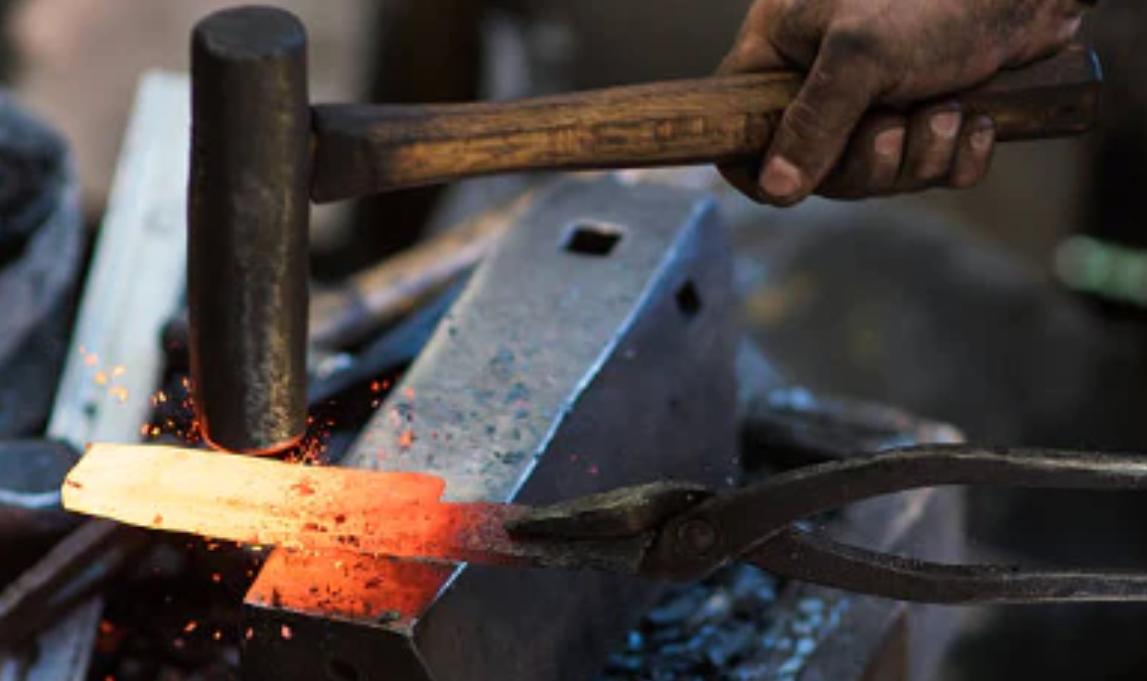
01. What is a Deba knife?
The Deba is a traditional Japanese knife designed specifically for butchering and filleting whole fish. It is an essential tool in Japanese kitchens and fish markets for precise, controlled work.
ー Purpose: Tailored for preparing whole fish without damaging the flesh
ー Blade: Thick spine and heavy, single-beveled blade offer stability and sharpness
ー Function: Can handle light bone work, such as chopping off fish heads or through small bones
ー Handle: Typically made from woods like magnolia, yew, or rosewood for comfort and beauty
ー Specialization: While it can cut soft meats or vegetables, it is optimized for fish—not suitable for large bone chopping like a cleaver
The Deba is not a general-purpose knife, but a dedicated tool for precision fish preparation.
02. When is a Deba used?
The Deba is ideal for preparing fish, especially when:
ー Filleting whole fish cleanly
ー Removing heads or tails
ー Slicing along the bone with a single-bevel blade, which allows smooth guidance and clean separation
Its robust blade makes it suitable for both delicate filleting and controlled bone cutting.
03. What is the origin of the name "Deba"?
The Deba is a type of knife unique to Japan, originating from Sakai city in Osaka during the Edo period's Genroku era.
Its name has a unique origin; it is said to have been named after the blacksmith from Sakai who developed it, who had prominent front teeth.
04. What is a comfortable length for a Deba?
The ideal Deba size depends on the fish size and intended use:
ー 120mm: For small fish like sardines or smelt
ー 165mm: Versatile size for a wide range of small-to-medium fish
ー 180mm+: For larger fish such as salmon or yellowtail
Choosing the right size ensures better control and safer handling.
05. Can a Deba cut through bones?
Yes, but only to a certain extent. Consider the following:
ー Small bones and cartilage: Easily cut with no risk
ー Medium fish bones (e.g., mackerel): Cuttable with careful technique
ー Large fish bones or animal bones: Not recommended — use a specialized bone-cutting knife instead
Using a Deba beyond its intended capacity may damage the blade or cause injury.

The Origin of Craftsmanship
-
Nurturing Your Tool: The Handle That Connects the Craft and the User’s Care
The handle of a deba knife is actually the part that bears the most strain. Each time you cut through a fish, immense pressure is focused on this area. That’s why it’s so crucial to catch even the smallest cracks or splits early and take care of them promptly. If ignored, moisture can seep in, leading to rust in the internal metal parts—a process that could shorten the life of your knife.
-
Treat your knife not as something to ‘use and discard,’ but as a tool to nurture and maintain. If you notice any irregularities, don’t hesitate to consult a professional knife craftsman. That small bit of effort can ensure your knife remains a reliable extension of your hand for years to come. This is a tool imbued with both the craftsmanship of the maker and the care of the user—treat it with the respect it deserves.



